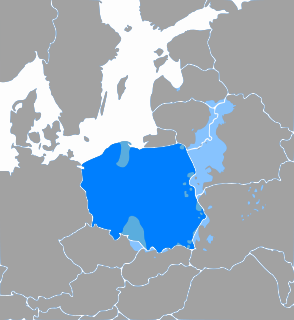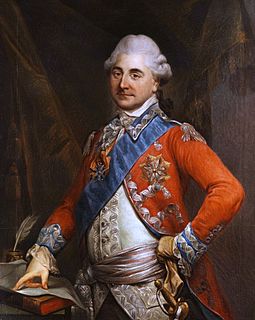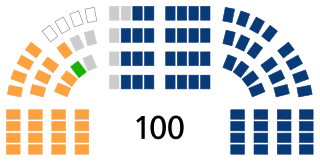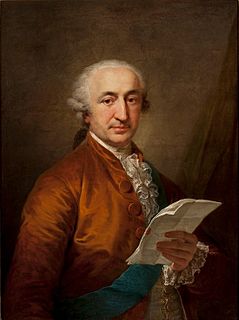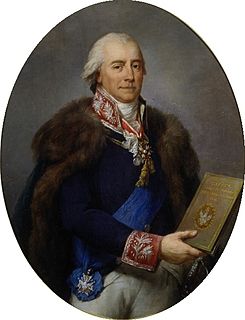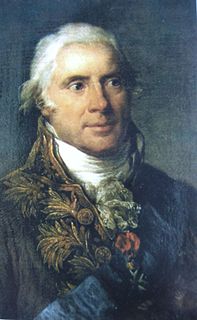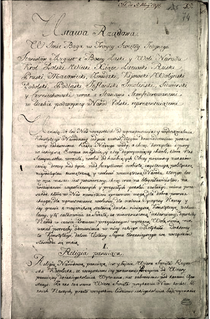
The Constitution of 3 May 1791 was a constitution adopted by the "Great Sejm" for the Polish–Lithuanian Commonwealth, a dual monarchy comprising the Crown of the Kingdom of Poland and the Grand Duchy of Lithuania. The Constitution was designed to correct the Commonwealth's political flaws and had been preceded by a period of agitation for—and gradual introduction of—reforms, beginning with the Convocation Sejm of 1764 and the consequent election that year of Stanisław August Poniatowski as the Commonwealth's last king.

Count Roman Ignacy Potocki, generally known as Ignacy Potocki, was a Polish nobleman, member of the influential magnate Potocki family, owner of Klementowice and Olesin, a politician, writer, and office holder. He was the Marshal of the Permanent Council in 1778–1782, Grand Clerk of Lithuania from 1773, Court Marshal of Lithuania from 1783, Grand Marshal of Lithuania from 16 April 1791 to 1794.

Franciszek Ksawery Branicki was a Polish nobleman, magnate, count, diplomat, politician, military commander and one of the leaders of the Targowica Confederation. He was appointed the Great Crown Podstoli in 1764, Ambassador in Berlin in 1765, Master of the Hunt of the Crown in 1766–1773, Artillery General of Lithuania in 1768–1773, Ambassador in Moscow in 1771, Field Crown Hetman in 1773 and Great Crown Hetman of the Polish–Lithuanian Commonwealth between 1774 and 1794.

The Great Sejm, also known as the Four-Year Sejm was a Sejm (parliament) of the Polish–Lithuanian Commonwealth that was held in Warsaw between 1788 and 1792. Its principal aim became to restore sovereignty to, and reform, the Commonwealth politically and economically.

The Targowica Confederation was a confederation established by Polish and Lithuanian magnates on 27 April 1792, in Saint Petersburg, with the backing of the Russian Empress Catherine II. The confederation opposed the Constitution of 3 May 1791, which had been adopted by the Great Sejm, especially the provisions limiting the privileges of the nobility. The text of the founding act of the confederation was drafted by the Russian general Vasili Stepanovich Popov, Chief of Staff of Prince Grigori Alexandrovich Potemkin. Its purpose was proclaimed in the small town of Targowica and the Potocki's estate on May 14, 1792. Four days later two Russian armies invaded the Polish-Lithuanian Commonwealth without a formal declaration of war.
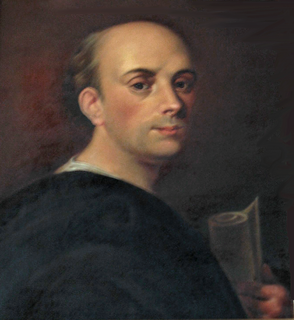
Scipione Piattoli was an Italian Catholic priest—a Piarist—an educator, writer, and political activist, and a major figure of the Enlightenment in Poland. After ten years as a professor at the University of Modena in Italy, he emigrated to the Polish-Lithuanian Commonwealth, where he became associated with several magnate families—the Potockis, Lubomirskis, and Czartoryskis. He was a member of Duchess Dorothea von Medem's court in Courland (Lithuania) and of King Stanisław August Poniatowski's court.

The Familia was the name of an 18th-century Polish political party led by the House of Czartoryski and allied families. It was formed towards the end of the reign of King of Poland Augustus II the Strong. The Familia's principal leaders were Michał Fryderyk Czartoryski, Grand Chancellor of Lithuania, his brother August Aleksander Czartoryski, Voivode of Ruthenia (Rus), their sister Konstancja Czartoryska,and their brother-in-law, Stanisław Poniatowski, Castellan of Kraków.
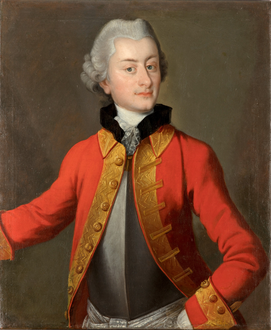
Seweryn Rzewuski was a Polish nobleman, writer, poet, general of the Royal Army, Field Hetman of the Crown, Voivode of Podolian Voivodeship and one of the leaders of the Targowica Confederation.
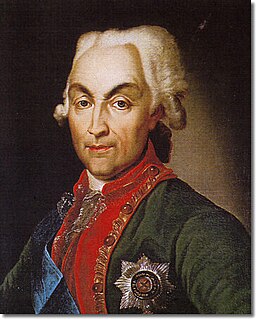
The Repnin Sejm was a Sejm of the Polish–Lithuanian Commonwealth that took place between 1767 and 1768 in Warsaw. This session followed the Sejms of 1764 to 1766, where the newly elected King of Poland, Stanisław August Poniatowski, attempted with some successes to push through reforms to strengthen the government of the Commonwealth. These reforms were viewed as dangerous by Poland's neighbors, who preferred a weak Commonwealth and did not want to see it threaten their own political and military aspirations. The Russian Empire sent ambassador Nicholas Repnin, who became the driving force behind the Sejm proceedings. The Repnin Sejm marked one of the important milestones in increasing Polish dependence on the Russian Empire, and turning it into a Russian protectorate. This dependent position was bluntly spelled out in Nikita Ivanovich Panin's letter to King Poniatowski, in which he made it clear that Poland was now in the Russian sphere of influence.

Piotr Ożarowski was a Polish noble (szlachcic), politic and military commander. Member of the infamous Confederation of Targowica, he reached the offices of Great Crown Hetman and castellan of Wojnice.

Ambassadors and envoys from Russia to Poland–Lithuania in the years 1763–1794 were among the most important characters in the politics of Poland. Their powers went far beyond those of most diplomats and can be compared to those of viceroys in the colonies of Spanish Empire, or Roman Republic's proconsuls in Roman provinces. During most of that period ambassadors and envoys from the Russian Empire, acting on the instructions from Saint Petersburg, held a de facto position superior to that of the Polish king, Stanisław August Poniatowski. Backed by the presence of the Russian army within the borders of the Polish–Lithuanian Commonwealth, and leveraging the immense wealth of the Russian Empire, they were able to influence both the king and the Polish parliament, the Sejm. According to their demands, the king dispensed the Commonwealth offices among the Russian supporters, and the Sejm, bribed or threatened, voted as the Russians dictated. The agenda of the Permanent Council was edited and approved by the Russian ambassador, and the members of the Council were approved by him.

Reichsgraf Otto Magnus von Stackelberg (1736–1800) was a diplomat of the Russian Empire. He served as an envoy in Madrid from 1767 to 1771, ambassador in the Polish-Lithuanian Commonwealth from 1772 to 1790 and in Sweden from 1791 to 1793.
Zamoyski Code was a major, progressive legislation, proposed by Andrzej Zamoyski, Grand Chancellor of the Crown of the Polish–Lithuanian Commonwealth, in 1776. This legislation was an attempt of codification of the previously uncodified law of the Commonwealth. It was opposed by several conservative and foreign factions and eventually rejected by the sejm of 1780.

The early modern era of Polish history follows the late Middle Ages. Historians use the term early modern to refer to the period beginning in approximately 1500 AD and lasting until around 1800.

The History of the Polish–Lithuanian Commonwealth (1764–1795) is concerned with the final decades of existence of the Polish–Lithuanian Commonwealth. The period, during which the declining state pursued wide-ranging reforms and was subjected to three partitions by the neighboring powers, coincides with the election and reign of the federation's last king, Stanisław August Poniatowski.

Zgromadzenie Przyjaciół Konstytucji Rządowej was the first modern Polish political party, formed in May 1791, shortly after the adoption of the Constitution of May 3, 1791, by the efforts of the Patriotic Party. The purpose of the Friends of the Constitution was to defend the reformed political system and to introduce further reforms.

The Seven Years' War, which ended in 1763, established a new pattern of political alliances in Europe. The Kingdom of Prussia, the Kingdom of Great Britain and the Russian Empire emerged as great powers, while the position of Austria, France, Spain, Sweden and the Ottoman Empire was weakened. As a result of the war, the Russian Empress, Catherine the Great, was in almost complete control of the Polish–Lithuanian Commonwealth. Catherine was supported by the Prussian monarch, Frederick the Great, who hoped to eventually annex Polish provinces of Royal Prussia and Greater Poland.

